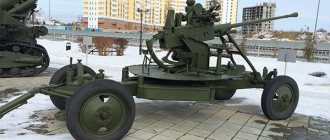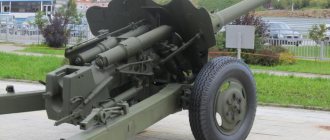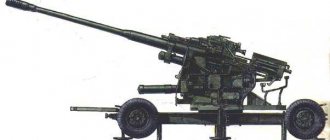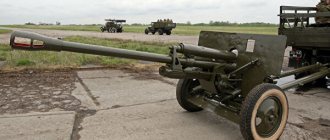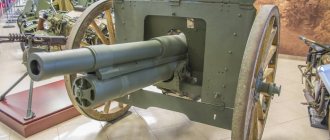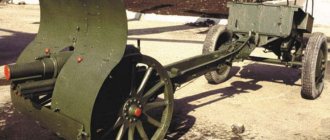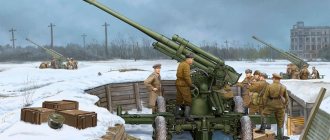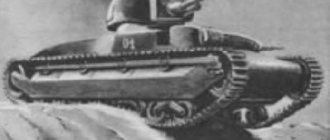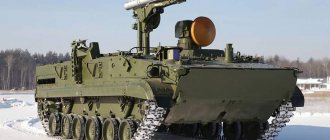Content:
There were special anti-tank units in the Red Army back in 1941.
Before the war, the formation of ten anti-tank artillery brigades began. In the fall of 1941, together with the soldiers of Panfilov’s division, Volokolamsk was defended by the artillerymen of the PAP anti-tank artillery regiments. But the experience of the first months of fighting showed that it is not enough to simply call the units anti-tank (and even give them the necessary materiel). More people were needed - with nerves stronger than the cores of sub-caliber shells. Those who will not flinch in a mortal duel with German tanks. Unlike Katyusha units or paratroopers transferred to the infantry, anti-tank soldiers were not given the Guards rank in advance. However, the pay rates for the newly formed anti-tank fighter units for privates and junior command personnel were even higher than for the guards. True, there were usually no fools to envy the soldiers with the anti-tank sleeve insignia.
The saying “long barrel - big salary - short life” appeared for a reason.
Another difference was the introduction of the position of deputy gunner, which was supposed to increase the survivability of the gun in battle.
In March of the last year of the war, it was the anti-tank units that were to become the main shield of the 3rd Ukrainian Front.
Organizational and staffing structure
BS-3 was in service with three-regiment light artillery brigades that were part of tank armies (48 ZIS-3 guns and 20 BS-3 guns). A number of BS-3 guns were used in the corps artillery of the Red Army of those years. In the post-war period, the semi-armored AT-P artillery tractor was usually used to tow the gun. The MT-LB (MT-LBV) was also used as a tractor. Somewhat earlier, the AT-L tractor and the ZIS-151 vehicle were used, in the last years of the war - the Y-12 tractor and the M-2 armored personnel carrier
Where can you see
- Russia - Museum of Russian Military History in the village of Padikovo, Istrinsky district, Moscow region.
- Russia, Trans-Baikal region, town. Chernyshevsk - near the monument to WWII participants.
- Russia, Vologda region, Vologda, Victory Park.
- Russia, Bashkortostan, Sterlitamak, Victory Park.
- Russia, Saratov region, Saratov, Victory Park on Sokolovaya Hill.
- Russia, Penza region, r. p. Zemetchino.
- Russia, Republic of Bashkortostan, Uchaly - Victory Stele.
- Russia, Ivanovo region, village Novo-Talitsy, st. Tsvetaeva - near the monument to WWII participants.
- Russia, Penza region, Nikolsk, st. Theater.
- Belarus, Nesvizh.
Classification of non-union complex sentences by meaning
Simple sentences within the BSP can express different meanings. The main types of non-union sentences, as well as the rules of punctuation when writing them, are given in the table.
| Meaning | What punctuation mark is used? | Rule | Examples |
| Simultaneity, sequence, enumeration | comma, semicolon | A comma is placed if the conjunction and can be placed between sentences in the BSP. A semicolon is placed in cases where the sentences in the BSP are remote in meaning or widespread. | The mouse ran, waved its tail, and the egg broke. Andrey returned late; Masha was already asleep. |
| Contrasts (comparisons) | dash | There is always a semantic opposition to something in a sentence; Between simple sentences you can put conjunctions a, but. | One hour to study, one hour to play. The winner is ahead - the coward is behind |
| Time and conditions | dash | The first sentence in the BSP indicates a time or condition; it can be preceded by conjunctions if, when. | The quieter you go, the further you'll get. If you like to ride, you also like to carry sleds |
| Comparisons | dash | Between the parts of the BSP it is possible to put alliances as if, as if. | If he gets angry, a thunderstorm will break out. If he smiles, he will disperse the clouds. |
| Accessions | dash | The second sentence expresses the connecting meaning and before it you can use the words such, such, so; or this word is used. | Bread is the head of everything - that’s what my grandmother taught. She was late again - this happened often. |
| Consequences | dash | The second sentence expresses the meaning of the consequence; it can be preceded by conjunctions so that, as a result of which. | The phone rang - I was distracted from work. The guests arrived and we quickly set the table. |
| Causes | colon | The second sentence expresses the meaning of the reason; it can be preceded by the conjunction because. | I woke up early: my sister woke me up. Sasha was in a hurry: she wanted to come first. |
| Explanations | colon | The second sentence explains the first; it can be preceded by conjunctions, namely, that is. | He could only advise one thing: never give up. It was wonderful by the river: we lay on the warm sand and admired nature. |
| Add-ons | colon | The second sentence complements the first; you can put the conjunction that or combinations of words in front of it: and see that; and hear that; and feel that, etc. | He noted: the girl has a beautiful dress. The man looked into the house: it was clean and cozy. |
Complex non-conjunctive sentences are studied in Russian language lessons in 9th grade.
Versions
Over the years, the 100mm turret has undergone several improvements, including more reliable operation and an increased rate of fire, new ammunition optimized for shooting down missiles, and compatibility with modern combat computers. There are three main variants of French 100 mm guns:
- Model 53
: The first round had to be fed manually, and subsequent rounds used recoil to autoload, firing at up to 60 rounds per minute. Uses electromechanical fire control with two manual command posts at the front of the turret. - The Modèle 64
is a direct descendant of the Model 53 and has a rate of fire of 78 rounds/min. This version can be connected to modern fire computers. - Modèle 68
In this model the turret has been lightened and can load the first shell automatically, but the rate of fire has been reduced to 60 rounds per minute.
This version can operate with automatic action and control, with only one manual station as a backup. This version was later improved to the CADAM standard ( Cadence Améliorée
, "improved rate of fire"), restoring the rate of fire to 78 rounds/min.
A derivative is the Model 100 TR
(used on the
La Fayette
), mechanically similar to the Model 68 but with stealth armor. Manual control removed. - Compact
: This weapon was only exported to China (see also Chinese Type 210 naval gun), Malaysia, Portugal and Saudi Arabia.
It is even lighter than the Model 68
, weighing only 19 tons, including the wheelhouse (14 tons only), deck and magazine. Later versions of the Mk 2 also fire faster, up to 90 rounds per minute. However, it is also limited to firing in short bursts of no more than 6 shots.
What have we learned?
We figured out which sentences are complex non-union sentences and what punctuation marks are placed in the BSP depending on their meaning.
- In BSP, sentences are connected not by conjunctions or allied words, but by intonation, the order of sentences, and the relationship between the type and tense of verbs.
- A comma, dash, colon, or semicolon can be placed between parts of the BSP.
- BSPs can consist of simple and complex sentences.
- There are BSPs with the meaning of condition, time, simultaneity, sequence, enumeration, comparison, addition, opposition, explanation, cause, effect, addition.
The concept of a non-union proposal
In non-union complex sentences, the means of connecting sentences-parts of the BSP are:
- intonation;
- the order in which proposals are arranged within the BSP;
- relationship between the aspect and tense of verbs in sentences.
In this way, BSPs differ from complex and complex sentences, in which conjunctions play this role.
Unconjunct sentences can consist of two or more simple or complex sentences, between which a comma, colon, dash or semicolon is placed, depending on the meaning.
Examples of non-union complex sentences with diagrams:
By evening it cleared up and the sun peeked out from behind the trees.
, .
He walked around the room anxiously: he was haunted by the news that his friend had told him.
: ,(which)].
If they call us, we’ll go and visit them.
– .
Do not confuse BSP with simple sentences with a dash. In the BSP there are always two syntactic bases, expressed by the subject and the predicate or only the predicate. Examples: Moscow is the capital of Russia (simple sentence). When evening comes, we'll talk (BSP).
Field artillery
The Austrian Landwehr artillery units had eight field artillery regiments and eight field howitzer regiments, while the Hungarian Honvéd had eight field gun regiments and one mobile horse artillery battalion. The main manufacturer of field guns with high technical characteristics was in Pilsen. This made it possible to use them without significant modernization until the end of the war, although due to pre-war savings, by the beginning of the war the reserve of guns was quite limited. Field artillery included:
guns
- 8 cm M.5 gun
- 15 cm field gun M.14
- 15 cm field gun M.15
howitzers
- 10-cm howitzer model 1899 - the main howitzer at the beginning of the First World War
- 10 cm field howitzer M.14
mortars
- 12 cm mortar M.15
- 12 cm mortar M.16
- 15 cm mortar M.15 M.E.
- 20 cm heavy mortar M.16
- 22.5 cm heavy mortar M.15
- 26 cm heavy mortar M.17
Short life
But if conical barrels never became widespread, then these guns had serious shortcomings. Our experts considered the main one to be the low survivability of the conical barrel (on average about 500 shots), that is, almost ten times less than that of the 3.7 cm Pak 35/36 anti-tank gun. (The argument, by the way, is unconvincing - the probability of survival for a light anti-tank gun that fired 100 shots at tanks did not exceed 20%. And not a single one survived to 500 shots.) The second complaint is the weakness of fragmentation shells. But the gun is anti-tank.
Nevertheless, the German guns made an impression on the Soviet military, and immediately after the war, work began on domestic anti-tank guns with a conical bore at TsAKB (Grabin Design Bureau) and OKB-172 (“sharashka”, where the prisoners worked). Based on the captured 7.5 cm PAK 41 cannon with a cylindrical-conical barrel, in 1946 the TsAKB began work on a 76/57-mm regimental anti-tank gun S-40 with a cylindrical-conical barrel. The S-40 barrel had a caliber at the breech of 76.2 mm, and at the muzzle - 57 mm. The total length of the barrel was about 5.4 m. The chamber was borrowed from the 85-mm anti-aircraft gun of the 1939 model. Behind the chamber there was a conical rifled part of 76.2 mm caliber with a length of 3264 mm with 32 rifling of constant steepness in 22 calibers. A nozzle with a cylindrical-conical channel is screwed onto the muzzle of the pipe. The weight of the system was 1824 kg, the rate of fire was up to 20 rounds/min, and the initial speed of the 2.45-kg armor-piercing projectile was 1332 m/s. Normally, at a distance of 1 km, the shell penetrated 230 mm armor; for such a caliber and weight of a gun, this was a fantastic record!
A prototype of the S-40 gun passed factory and field tests in 1947. The accuracy of combat and the armor penetration of armor-piercing shells of the S-40 was significantly better than that of the standard and experimental shells of the 57-mm ZIS-2 cannon that were tested in parallel, but the S-40 never entered service. The opponents' arguments are the same: the technological complexity of manufacturing the barrel, low survivability, and the low effectiveness of the fragmentation projectile. Well, besides, the then Minister of Arms D.F. Ustinov hated Grabin fiercely and opposed the adoption of any of his artillery systems.
Literature
- Shunkov V.N. Weapons of the Red Army. - Mn.: Harvest, 1999. - 544 p., ISBN 985-433-469-4
| Battalion and regimental guns | 45-mm howitzer mod. 1929 · 76 mm gun mod. 1927 · 76 mm gun mod. 1943 (OB-25) |
| Mountain guns | 76-mm mountain gun mod. 1909 · 76-mm mountain gun mod. 1938 |
| Divisional guns | 76 mm gun mod. 1902/30 · 76 mm gun mod. 1933 · 76 mm gun mod. 1936 (F-22) · 76-mm gun mod. 1939 (USV) · 76-mm gun mod. 1942 (ZIS-3) 107 mm gun mod. 1940 (M-60) · 122 mm howitzer mod. 1909/37 · 122 mm howitzer mod. 1910/30 · 122 mm howitzer mod. 1938 (M-30) · 152 mm mortar mod. 1931 (NM) |
| Corps and army guns | 107 mm gun mod. 1910/30 · 122 mm gun mod. 1931 (A-19) · 122 mm gun mod. 1931/37 A-19 · 152 mm howitzer mod. 1909/30 · 152 mm howitzer mod. 1910/37 · 152 mm howitzer mod. 1938 (M-10) · 152 mm howitzer mod. 1943 (D-1) · 152 mm gun mod. 1910/30 · 152 mm gun mod. 1910/34 · 152 mm howitzer-gun mod. 1937 (ML-20) |
| Weapons of great and special power | 152 mm gun mod. 1935 (Br-2) · 203 mm howitzer mod. 1929 · 203 mm howitzer mod. 1931 (B-4) · 210 mm gun mod. 1939 (Br-17) · 280 mm Schneider mortar, model 1914/15. · 280 mm mortar mod. 1939 (Br-5) · 305 mm howitzer model 1915 · 305 mm howitzer mod. 1939 (Br-18) |
| Mortars | 37-mm mortar-shovel · 50-mm mortar mod. 1938 · 50-mm mortar mod. 1940 · 50-mm mortar mod. 1941 · 82-mm mortar mod. 1936 · 82-mm mortar mod. 1937 · 82-mm mortar mod. 1941 · 82-mm mortar mod. 1943 · 107-mm mountain pack mortar mod. 1938 · 120 mm mortar mod. 1938 · 120 mm mortar mod. 1943 · 160 mm mortar mod. 1943 |
| Anti-aircraft guns | 25 mm gun mod. 1940 (72-K) · 37 mm gun mod. 1939 (61-K) · 76-mm gun mod. 1914 · 76 mm gun mod. 1931 · 76 mm gun mod. 1938 · 85 mm gun mod. 1939 (52-K) |
| This is a draft article about artillery. You can help the project by adding to it. |
Service and combat use
The anti-tank artillery battalions of the motorized rifle divisions of the USSR Armed Forces included two anti-tank artillery batteries consisting of six 100-mm anti-tank guns T-12 (MT-12).
In the Afghan war 1979-1989. 100-mm MT-12 guns, which were in service with individual anti-tank artillery divisions
(
optad
) as part of 3 motorized rifle divisions (370th optical division, 738th optical division, 1377th optical division) by dispersing linear platoons across outposts, they were used by Soviet troops to protect communications and especially important facilities, headquarters, and airfields.
In the Armed Conflict in Transnistria (1992), 100-mm MT-12 cannons were used against T-64 tanks.
During the First Chechen War, 100-mm MT-12 cannons were used for artillery preparation during the assault on the village of Pervomaisky.
During the Armed Conflict in eastern Ukraine, it was widely used by both sides of the conflict.
In the Syrian Civil War it is used by the armed forces of the Syrian Arab Republic.
In service
- USSR USSR - passed to Russia
- Bulgaria Bulgaria - 89 BS-3, as of 2007[8]
- Yemen Yemen - 20 BS-3, as of 2007[9]
- Kyrgyzstan Kyrgyzstan - 18 BS-3, as of 2007[10]
- Mali Mali - 6 BS-3, as of 2007[11]
- Mozambique Mozambique - 20 BS-3, as of 2007[12]
- Mongolia Mongolia - as of 2007[13]
- Nicaragua Nicaragua - 24 BS-3, as of 2007[14]
Design
OSCE observer photo of MT-12 Ukrainian troops. February 2015.
Structurally, the gun is a smooth-bore anti-tank gun on a classic two-frame carriage.
Sights
The following artillery sights are installed on the MT-12:
- For direct fire in the daytime (at a visible target) - an OP4MU-40U optical sight, which is removed from the gun only before long and difficult marches or during long-term storage;
- For firing from closed positions (at an invisible target) - mechanical sight S71-40 with a PG-1M panorama and a K-1 collimator;
- For night shooting - 1PN35, night sight APN-6-40 "Brusnika"; or 1PN53, night sight APN-7;
The PG-1M panorama is an optical device that is necessary for accurately aiming a gun at a target in horizontal and vertical planes.
The K-1 collimator is an optical device designed for horizontal aiming of a gun in the absence of natural aiming points or in conditions of poor visibility (in fog, snowfall, smoke in the firing position).
The Luch-S71M lighting device is also used to illuminate the gun sights at night.
Transportation
Since the MT-12 uses wheels from a ZIS-150 truck with a “GK” tire (sponge rubber - size 9.0-20, model Y-37), transportation was carried out by towing with an MT-L (MT-LB) crawler tractor , tractor-trailers Ural-375D and Ural-4320. When driving on snow, the LO-12 ski rig was used.
usage
The 100 mm gun was used in the French Navy on most warships equal to or larger than the Avisos (especially the A69, of which 20 were built and exported). Aircraft carrier Charles de Gaulle
with its MBDA-only protection, Aster is the main exception. Future Horizon CNGF frigates are also expected to be equipped with the 76 mm Oto-Melara gun. It is not yet known whether this is a general trend away from the 100 mm gun or just a special case of some specialized vessels.
The 100mm has been sold overseas and is used by the navies of Argentina, Belgium, China, Portugal, Turkey, Brazil, Saudi Arabia, Bulgaria and Germany (installed on Köln-
and
Hamburg
.
retired) etc. Belgian
Wielingen
-class frigates equipped with this system were sold to Bulgaria in 2004-2008.
Project evaluation
Analogs
"Rapier" of the 612th anti-tank division of the Romanian Army.
- The 100-mm D-60
is an experimental divisional towed anti-tank gun on a D-30 howitzer carriage, developed at OKB-9. - Tun antitanc calibru 100 mm model 1975/77ruen
- 100-mm towed rifled anti-tank gun model 1975/77 with an effective BOPS firing range of up to 1.7 km. - 100 mm anti-tank gun Type 73
- The Type 73 100 mm towed smoothbore anti-tank gun was developed in the mid-1970s. - 100 mm anti-tank gun Type 86
- The Type 86 100 mm towed smoothbore anti-tank gun was developed in the late 1980s. In motorized infantry divisions, the PLA is used as the main anti-tank artillery weapon. - The 105 mm anti-tank gun "No. 105"rupl
is an Austrian anti-tank gun developed in the 1980s with a BOPS firing range of up to 5.8 km (almost twice as far as the Rapier). - 100mm protitankový kanón vzor 53
(factory designation
Škoda A20
) - developed by the Czechoslovaks as a development of the BS-3 concept, 100-mm guns of the 1953 model were in service with the Czechoslovak army from 1953 until the early 1990s.
Advantages
Versatility:
The MT-12 gun can be used both to destroy tanks, armored personnel carriers and other armored vehicles, and to fire at armored caps, embrasures of long-term and wood-earth firing points, as well as to destroy enemy personnel and fire weapons located outside shelters and behind light shelters.
Rate of fire:
The average rate of aimed fire from a 100 mm MT-12 is approximately 6 rounds per minute. Theoretically, the maximum rate of fire from the MT-12 can reach 14 rounds per minute, practically - 10 rounds per minute.
- Relative cheapness of ammunition.
- Reliability.
- Easy to use.
Sources
- kuk Adjustierungsvorschrift (Ausgabe von 1912) (German)
- kuk Kriegsministerium: Dislokation und Einteilung des kuk Heeres, der kuk Kriegsmarine, der kk Landwehr und der ku Landwehr
.
In: Seidels kleines Armeeschema
. Seidel & Sohn, Wien 1913, . (German) - Unterrichtsmaterial und Dienstvorschriften der kuk Armee im Kriegsarchiv in Wien. (German)
- Moritz Ritter von Brunner: Die beständige Befestigung.
Für die kuk Militärbildungsanstalten und zum Selbstunterrichte für Offiziere aller Waffen herausgegeben . 7. vollständig umgearbeitete Auflage. LW Seidel u. Sohn, Wien 1909. (German) - Erwin Anton Grestenberger: Kuk Befestigungsanlagen in Tirol und Kärnten 1860–1918. Verlag Österreich ua, Wien 2000, ISBN 3-7046-1558-7 (German)
- M. Christian Ortner: Die österreichisch-ungarische Artillerie von 1867 bis 1918. Verlag Militaria, Wien 2007, ISBN 978-3-902526-12-0 (German)
- Łukasz Chrzanowski: Artyleria Austro-Węgierska 1860—1890. FORT, Przemyśl 2008, ISBN 978-83-923657-7-8, (Architectura et ars militaris 16) (Polish)
Ammunition
In towed position.
The gun's ammunition includes several types of sub-caliber, cumulative and high-explosive fragmentation shells, as well as Kastet guided anti-tank missiles. Carryable ammunition: 20 rounds, of which 50% are BPS, 20% are OFS, 30% are KS..
Armor-piercing sabot shells (APS)
- 100-mm UBM1 and UBM2 rounds with armor-piercing sub-caliber shells ZBM1 (with a core) and ZBM2 (without a core) are designed for firing at tanks, self-propelled guns and other armored targets.
- The 100-mm armor-piercing sub-caliber round UBM10 with a core, with the armor-piercing sub-caliber projectile ZBM24 with a swept warhead, is designed to destroy armored vehicles.
- Armor-piercing sub-caliber round UBM15, R&D “Valshchik”.
High-explosive fragmentation shells (HEF)
- The 100-mm UOF3 round with the 3OF15 high-explosive fragmentation projectile, equipped with a B-429E fuse, is intended for firing at manpower, firing points, field engineering structures and other targets. The initial projectile speed is 667 m/s.
- 100-mm high-explosive high-explosive fragmentation round UOF12 with a high-explosive fragmentation projectile 3OF35, designed to destroy enemy personnel, field fortifications, field-type engineering structures, artillery firing positions, mortars, rocket launchers, infantry fire weapons. Initial projectile speed 663 m /With.
Cumulative projectiles (CS)
- 100-mm UBK2 and UBK2M rounds with cumulative fragmentation shells ZBK3 and ZBK3M, equipped with a GPV-2 fuse, are designed for direct fire at armored targets with powerful armor protection, at light shelters and manpower. NII-24.
- 100-mm cumulative increased armor penetration rounds UBK8 and UBK8M with cumulative projectiles 3BK16 and 3BK16M are designed to destroy armored targets, as well as manpower, fortifications and engineering structures, artillery firing positions, mortars, and rocket launchers.
3UBK10 and 3UBK10-1 rounds with a 9M117 guided missile.
Inert (blank: training and practical) projectiles
- High-explosive high-explosive fragmentation inert shot UOF12 IN;
- Cumulative inert shot UBK8 IN;
- 3UP4 shot with a practical 3P7 cumulative projectile (analogous to the 3BK3M projectile);
- Shot with a practical cumulative projectile 3P27 (analogous to the 3BK16M projectile);
- Blank shot 4X20
- Blank shot X20N;
- Blank shot X20P;
- Charge for hydroshooting.
The history of the creation of the Rapier anti-tank gun
As mentioned above, the advent of rocket-propelled grenade launchers and guided missile systems radically changed the tactics of fighting armored vehicles on the battlefield. The first anti-tank guns appeared at the end of the First World War. During the interwar period, this type of artillery actively developed, and its “finest hour” was the Second World War. Just before the war, the armies of the leading countries of the world received a new generation of tanks: the Soviet KV and T-34, the British Matilda, the French S-35, Char B1. These combat vehicles had a powerful power plant and anti-ballistic armor, which the first generation anti-tank guns could not cope with.
Already in 1942, the first hand-held rocket launcher, the Bazooka, was adopted by the American army, which turned out to be a very effective means of combating enemy armored vehicles. The Germans became acquainted with this type of weapon during the fighting in North Africa and already in 1943 they established mass production of their own analogues. By the end of World War II, grenade launchers became one of the main enemies of tank crews. And after its completion, anti-tank missile systems (ATGMs) began to enter service with the armies of the world, capable of hitting armored vehicles at considerable distances with great accuracy.
It is unknown how the fate of the domestic anti-tank artillery would have developed in the future if the designers had not proposed one interesting innovation - the use of a smooth-bore gun. In 1961, the T-12 100 mm cannon entered service with the Soviet army; it had no rifling in the barrel. The projectile was stabilized in flight by stabilizers that opened immediately after the barrel was cut.
The fact is that the initial projectile speed of smooth-bore guns is much higher than that of rifled guns. In addition, a projectile that does not rotate in flight is much better suited for a shaped charge. We can also add that the service life of such a barrel is higher than that of a rifled one.
The T-12 was developed by specialists from the design bureau of the Yurga Machine Plant. The gun turned out to be very successful with excellent tactical and technical characteristics. At the end of the 60s, they decided to modernize the gun, equipping it with a new and improved carriage. The reason was that at this time the troops were switching to a new artillery tractor, which had greater speed. It can also be added that a smoothbore gun is much more suitable for firing guided ammunition, although probably in the 60s the designers did not think too much about this issue. The gun with the new carriage received the designation MT-12; its mass production began in 1970.
In the mid-70s, on the basis of the MT-12, specialists from the Tula Instrument Design Bureau developed the Kastet anti-tank complex. It included a guided projectile as part of a unitary shot, as well as guidance and aiming equipment. The projectile was controlled by a laser beam. "Kastet" was put into service in 1981.
In the same year, the MT-12R modification was created, equipped with the Ruta radar station. Production of the radar sight continued until 1990.
Features of the tactical use of Soviet and German anti-tank guns
Combat use is complex. The type of weapon (or equipment) itself does not act on its own - it is intended to act in interaction with other equipment or weapons. First of all, communication means are needed to organize tactical interaction.
In the practical application of VHF (VHF) radio communications in the 30s of the last century, Germany was significantly ahead of the USSR. In 1936, VHF radio stations were adopted in Germany - Fug-5 (for tanks) and Torn Fu d2 (for infantry). Both radio stations operated at frequencies from 27 to 33.3 MHz.
By 1943 - by the time the 8.8 cm Pak 43 L/71 anti-tank gun appeared, these types of radio stations were upgraded to VHF radio stations - Fug-15 (for all types of self-propelled guns and self-propelled tractors) and Feldfu.f (for infantry and anti-tank crews artillery) figures 10 and 11.
Figure 10. VHF radios - Fug-15.
Figure 11. VHF radio stations – Feldfu.f.
There was nothing even close to equal in service with the anti-tank units of the Red Army in 1943. There was a desire to have it, but, unfortunately, Soviet desires did not always keep pace with Soviet capabilities. Soviet analogues of VHF radios - the R-123 was put into service in 1960, and the R-105 - into service in 1967. You don’t need to have much knowledge to notice who copied whom and when.
Besides. By 1943, the Wehrmacht units were armed with the Sd.Kfz 10/4 (10/5) half-track transporter - Figures 12 and 13. This type of transporter was the most common in Germany during the Second World War - a total of ( all versions of the conveyor) 14,000 vehicles.
Taking into account the fact that a total of 2,100 anti-tank guns 8.8 cm Pak 43 L/71 were produced, we can conclude that there were no problems with transporting the gun in Germany at all. Even more. And without the presence of the Sd.Kfz 10/4 (10/5) half-track transporter, there was a whole family of other half-track transporters.
Figure 12. External view of the Sd.Kfz 10/4 half-track transporter.
Figure 13. Sd.Kfz 10/4 transporter with 8.8 cm Pak 43 L/71 anti-tank gun.
And it is precisely from the technical characteristics of half-track transporters that it becomes clear why the Sd.Kfz 10/4 (10/5) model was chosen. This is not just a transporter - it has an armored cabin. For comparison, the first Soviet tracked transporter for anti-tank artillery - MT-LB (a multi-purpose tractor, lightly armored, but in fact - “small, cramped, light, useless”) was put into service only in the mid-70s of the last century.
By 1943, the situation with Soviet tractors for anti-tank artillery was at an extremely low level. Since 1943, the production of the Y-12 artillery tractor has just begun (Figure 14). The USSR frankly did not have enough of its own diesel engines for this tractor, so they and the transmission were bought in the USA - GMC-4-71
It is not difficult to note that the I-12 artillery tractor did not have the same level of armor as the German Sd.Kfz 10/4
Figure 14. Soviet artillery tractor Y-12 in the Czech Republic, photo from 1945.
The technical characteristics of both tractors are summarized in Table 1
It is not difficult to note that the German half-track tractor Sd.Kfz 10/4 had smaller dimensions, but greater capabilities in comparison with the Soviet tractor Y-12
All of the above determined the possibilities of application. It was far from necessary for the Germans to use anti-tank regiments to stop the advancing Soviet tanks. Using excellent radio communications (tactical level, of which there were far more than two varieties), the Germans were generally able to use batteries as independent platoons.
Some of the guns were used first. While the second, third and other parts of the guns entered into battle either sequentially or simultaneously. In this case, the first part of the guns could not only leave the battle, but also move to other firing positions and re-enter the battle. This is exactly the kind of opportunity that the Soviet anti-tank gunners did not have.
As a conclusion
Any type of weapon or military equipment is created to meet the specific requirements of tactical use. An example with a German anti-tank gun - 8.8 cm Pak 43 L/71, with a barrel length of 71 calibers - is indicative and clear. Visibility comes precisely in relation to issues of tactics, when it is not just an anti-tank weapon itself that is being created, but when there are additional (and no less important) additional means for successful use.
Modifications of the MT-12 gun
The basic version of the Rapier gun began to enter service with the troops starting in 1970. After this, the gun was modernized several times.
MT-12K (2A29K)
This version of the gun was adapted to launch Kastet anti-tank guided missiles. For this purpose, the gun sight was supplemented with special equipment - 9Sh135. Using this equipment, the crew was able, by controlling a laser “pointer,” to direct missiles precisely at the target. Modified guns began to enter service with the troops in 1981.
MT-12R (2A29R)
This version of the Rapier was equipped with the new Ruta sighting system (1A31). The operating principle is radar. The equipment made it possible to detect targets and conduct targeted fire at them in the dark, with heavy smoke and in thick fog. The gun was put into service in 1981.
M87 TOPAZ
This modification of the gun was made in Yugoslavia. The main difference from the MT-12 is the carriage. The TOPAZ gun was installed on the “wheels” of the towed howitzer D-30, or more precisely, its Yugoslav version - D-30J.
Damaged (wheels torn off) M87 TOPAZ cannon
As a result, it became possible to quickly turn the gun in any direction by 360 degrees, which is convenient when firing at suddenly appearing targets. But this advantage comes at the cost of increasing the gun's vulnerability. The gunner sitting in a high chair is in the most dangerous position. Additional accessories include a removable laser rangefinder.
Despite the fact that the MT-12 no longer meets the requirements for a modern anti-tank weapon, the use of this gun will likely continue until the barrels are completely worn out. In local conflicts, when neither side has high-tech weapons, this weapon can demonstrate quite high efficiency, and in more modern armies it will be assigned the role of an auxiliary weapon.
Author of the article:
Fedorov Dmitry
Soviet analogue - 100-mm anti-tank gun BS-3
The history of the appearance of the B-34 gun goes back to 1931, when the command of the Soviet Navy ordered a 100 mm (102 mm) anti-aircraft gun, designated B-14. The B-14 gun was not accepted for service; instead, in 1936, work began on the B-34 gun, 100 mm caliber.
Despite the fact that the barrel length of the 100-mm B-34 gun was increased from 45 to 56 calibers - this did not significantly improve the characteristics of the anti-aircraft gun - the effective firing range at an air target was 8,500 meters. For the anti-aircraft artillery of the Red Army, this was not bad. For comparison. The German anti-aircraft gun - 8.8 cm Flak 18/36 (Krupp company) with the same barrel length of 56 calibers ensured hitting the target at the same altitudes - up to 9,900 meters.
Did you notice the discrepancy between the caliber and the final result? A German anti-aircraft gun with a smaller caliber had an output comparable in height to a Soviet anti-aircraft gun of a larger caliber. Then, when the Germans needed a more powerful anti-aircraft gun, it appeared - 10cm Flak 38 - effective firing range, which was 11,400 meters
And besides, Germany was the first country that, during World War II, switched to the use of anti-aircraft guided missiles.
The B-34 gun had two problems. The first problem is that the customer body RKMF could not formulate the requirements (TTZ) that it set before the designers. There was only one criterion - firing range. But at the same time, the “political leadership” could not decide on the length of the barrel (so that the industry could produce). But at the same time, an altitude of 15,000 meters was required. For Soviet industry, this figure was outright fantastic.
The second problem concerned all Soviet mass production - lack of quality. And not only in artillery, but also in tanks, aircraft, small arms and steam locomotives, among others. If the prototype had high characteristics, then in mass production these characteristics were much lower.
Thus, a projectile fired from a prototype B-34 cannon when firing at air targets - according to unverified information - reached a height of 14,450 meters. However, Admiral of the USSR Fleet Kuznetsov left memories in which he indicated that firing from these guns never exceeded a height of 8,500 m. And after the sinking of the battleship Marat (Hans-Ulrich Rudel) in Kronstadt on September 23, 1941, a 100-mm B- 34 were used only for firing at ground targets.
In 1943, after the failure of the “Kursk Bulge”, in which the defending units of the Red Army lost 10 times more tanks than the advancing Germans, it was decided to make a powerful anti-tank gun comparable in characteristics to the German 88-mm cannon mounted on the Elefant self-propelled gun. A naval 100-mm anti-aircraft gun came into the field of view of the “design engineers” of the Grabin Design Bureau.
And the gun was made by adding a muzzle brake - the gun was named BS-3 (which meant “land Bolshevik”). However, having considered that the gun had high ballistic characteristics, Grabin’s design bureau came across the fact that these characteristics were not as high as they actually were. Lengthening the gun barrel by 3 calibers did not help either.
The only thing that was done with skill on the 100-mm BS-3 anti-tank gun was the installation of a muzzle brake - an outright copy of the German one (most likely by order). Grabin's design bureau did this under the same influence that occurred with the 76.2-mm ZiS-3 divisional gun. The muzzle brake of which, despite its effectiveness, jammed the low frequencies of any person during shooting located within a radius of 150 meters from the gun.
Historical sketch
76-mm divisional gun model 1942 (zis-3)
Battle of the Swiss with the Burgundians at Granson (1476). Miniature of the Berne Chronicle by Diebold Schilling the Elder
6-pounder mountain howitzer used in field battles of the American Civil War, 1863.
Historical emergence of field artillery
associated with the invention of the wheeled carriage, because before its appearance (XIV-XV centuries) artillery was too bulky and inactive, which limited its scope of application mainly to the capture and defense of fortresses (see fortress artillery and siege artillery). The wheeled carriage allowed fire weapons and artillery units to actively maneuver on the battlefield and take part in battles along with infantry and cavalry. It is known that the first to use light field artillery in battle was the condottiere B. Colleoni (1467).
Vaclav Sochor. "The Austrian "battery of the dead" at the Battle of Sadovo 1866." Military History Museum (Vienna)
In the Russian army, the first wheeled carriages appeared at the end of the 15th century, and from the second quarter of the 16th century, all types of artillery weapons began to be equipped with wheeled carriages. Later (in the 17th-18th centuries) there was a decrease in the total mass of the tools and an increase in their mobility (see unicorn). Before the start of the First World War, Russian field artillery
included light, horse, mountain, horse-mountain, mortar and heavy artillery.
A battery of Russian 76.2 mm field guns in Prussia, 1914.
Accordingly, types of field artillery
Field troops of the Russian Army The Russian Armed Forces of the imperial period included:
- light:
- horseback:
- mountain:
- equestrian mountain:
- mortar:
- heavy:
For lower ranks, members of special teams of field artillery, reconnaissance officers, on August 11 (August 24), 1907, by the Highest Decree of Emperor Nicholas II, an external insignia was established - the breastplate of a field artillery reconnaissance officer.
Characteristics and properties of ammunition
100 mm field gun mod. 1944 BS-3 in the Batey ha-Osef Museum, Israel
| Ammunition for 100 mm field gun model 1944 BS-3 | |||||||||
| Shot brand | Projectile type | Projectile brand | Shot weight, kg | Projectile weight, kg | Explosive mass, g | Fuse brand | Muzzle velocity, m/s | Direct shot range at a target 2 m high | Year of adoption |
| Armor-piercing shells | |||||||||
| UBR-412 | armor-piercing sharp-headed, tracer | BR-412 | 30,10 | 15,88 | 65 | MD-8 | 897 | 1040 | 1944 |
| UBR-412B | armor-piercing blunt-headed with a ballistic tip, tracer | BR-412B | 30,10 | 15,88 | 65 | MD-8 | 897 | 1040 | 1944 |
| High-explosive fragmentation shells | |||||||||
| UO-412 | naval fragmentation grenade | O-412 | n/a | 15,94 | n/a | RGM | 898 | 1200 | |
| UOF-412 | high explosive | OF-412 | 30,20 | 15,60 | 1460 | RGM | 900 | 1100 | |
| UOF-412U | high explosive, with reduced charge | OF-412 | 27,10 | 15,60 | 1460 | RGM | 600 | 730 |
| Armor penetration table for BS-3 | |||||
| Projectile \ Distance, m | 500 | 1000 | 1500 | 2000 | 3000 |
| BR-412 | |||||
| (meeting angle 90°) | 155 | 135 | 115; 116 | 100; 99 | 75 |
| (meeting angle 60°) | 125 | 110 | 95 | 80; 87 | 60 |
| BR-412B | |||||
| (meeting angle 90°) | 160; 162 | 150; 149 | 135; 132 | 125; 124 | 105 |
| (meeting angle 60°) | 130 | 120 | 110 | 100 | 85 |
| (meeting angle 35°) | 73 | 68 | 62 | 57 | n/a |
| BR-412D | |||||
| (meeting angle 90°) | 200 | 185 | 170 | 155 | 125 |
| (meeting angle 60°) | 150 | 140 | 130 | 120 | 100 |
| 3BM8 | |||||
| (meeting angle 90°) | n/a | n/a | n/a | 290 | n/a |
| (meeting angle 30°) | n/a | n/a | n/a | 80 | n/a |
| BK5M | |||||
| (meeting angle 90°) | 390 at any distance | ||||
| (meeting angle 30°) | 180 at any distance | ||||
| It should be remembered that at different times and in different countries different methods for determining armor penetration were used. As a consequence, direct comparison with similar data from other guns is often impossible. |
Production
| Production of the BS-3 gun | |||||||||
| year | 1944 | 1945 | 1946 | 1947 | 1948 | 1949 | 1950 | 1951 | Total |
| Plant No. 7 | 66 | 720 | 1015 | 306 | 201 | 256 | 107 | 200 | 2871 |
| Plant No. 232 | 275 | 420 | 250 | — | — | — | — | — | 945 |
| total | 341 | 1140 | 1265 | 306 | 201 | 256 | 107 | 200 | 3816 |
Notes
- Shirokorad A. B. Smooth-bore anti-tank guns (“Octopus” and “Rapier”) // Equipment and weapons yesterday, today, tomorrow...: Journal. - Moscow: ROO "Techinform", 1997. - No. 10
- Shirokorad A. B.
Encyclopedia of domestic artillery. - Minsk: Harvest, 2000. - P. 631-632. — 1156 p. — ISBN 985-433-703-0. - (unavailable link). Retrieved April 11, 2014.
- International Institute for Strategic Studies.
The Military Balance 2016 / James Hackett. - London: Taylor&Francis, 2016. - P. 82. - 504 p. — ISBN ISBN 9781857438352. - The Military Balance 2022. - P. 205.
- International Institute for Strategic Studies.
The Military Balance 2016 / James Hackett. - London: Taylor&Francis, 2016. - P. 185. - 504 p. — ISBN ISBN 9781857438352. - International Institute for Strategic Studies.
The Military Balance 2016 / James Hackett. - London: Taylor&Francis, 2016. - P. 187. - 504 p. — ISBN ISBN 9781857438352. - International Institute for Strategic Studies.
The Military Balance 2016 / James Hackett. - London: Taylor&Francis, 2016. - P. 188. - 504 p. — ISBN ISBN 9781857438352. - International Institute for Strategic Studies.
The Military Balance 2016 / James Hackett. - London: Taylor&Francis, 2016. - P. 275. - 504 p. — ISBN ISBN 9781857438352. - International Institute for Strategic Studies.
The Military Balance 2016 / James Hackett. - London: Taylor&Francis, 2016. - P. 190. - 504 p. — ISBN ISBN 9781857438352. - International Institute for Strategic Studies.
The Military Balance 2016 / James Hackett. - London: Taylor&Francis, 2016. - P. 203. - 504 p. — ISBN ISBN 9781857438352. - International Institute for Strategic Studies.
The Military Balance 2016 / James Hackett. - London: Taylor&Francis, 2016. - P. 208. - 504 p. — ISBN ISBN 9781857438352. - International Institute for Strategic Studies.
The Military Balance 2016 / James Hackett. - London: Taylor&Francis, 2016. - P. 205. - 504 p. — ISBN ISBN 9781857438352. - The Military Balance 2010. - P. 245.
- The Military Balance 2013. - P. 117.
- The Military Balance 2010. - P. 124.
- The Military Balance 2010. - P. 189.
- (unavailable link). Retrieved December 9, 2012.
- (unavailable link). Retrieved January 2, 2013.
